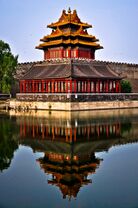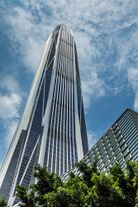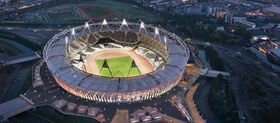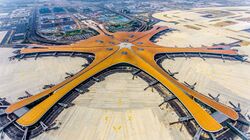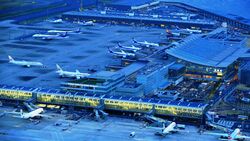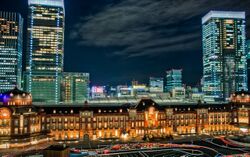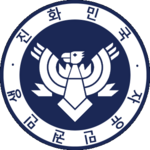Daedo
Daedo | |
|---|---|
Special City | |
| Nickname(s): City of the East, Dragon City, The City | |
| Motto(s): 고요한 아침의 수도 ("Capital of the Morning Calm.") | |
| Country | |
| Special City | Daedo Special City (coterminous) |
| Subdivisions | Districts
|
| Daedo founded | c. 68 AD |
| District Division | Capital District |
| Government | |
| • Type | Daedo Metropolitan Assembly |
| • Elected body | Daedo Metropolitan Assembly |
| • Special City Administrator | Seungjun Jin (N) |
| • Senator | 5 Sangseowon Representatives |
| Area | |
| • Special City | 6,178.07 km2 (2,385.37 sq mi) |
| • Land | 5,990.87 km2 (2,313.09 sq mi) |
| • Water | 187.2 km2 (72.3 sq mi) |
| Highest elevation | 442.3 m (1,451.1 ft) |
| Lowest elevation | 0.0 m (0.0 ft) |
| Population (2019) | |
| • Density | 3,499.0/km2 (9,062/sq mi) |
| • Metro | 21,617,281 |
| Demonym | Daedoite/Easterner |
| Time zone | UTC+09:00 (Zhenia Eastern Standard Zone (ZEST)) |
| ZIP Code | 00001-00100 |
| Zhenia Federal Area Code | DG |
| City Flower | Zhenian Peony |
| Website | www.daedocity.zhen.gov |
Daedo (Classic Zhenian: 大都, Modern Zhenian: 대도, meaning 'Great Capital' in Zhenian), formally Daedo Special City (Classic Zhenian: 大都特別市, Modern Zhenian: 대도특별시), is the capital and most populous city of the Republic of Zhenia. As the only city in the nation administratively designated as a special city, it is governed by the Daedo Metropolitan Government. It faces the Gulf of Danguk to the west and is surrounded by Chungmu Province, while the Danbon River, before emptying into the Gulf of Danguk in the Danbon Estuary, passes right through it. Subdivided into 17 districts, it is home to over 21.6 million residents, making its metropolitan area, the Capital Megalopolis, the single largest metropolitan area in the nation.
With historical records detailing its existence dating its origins back to 68 AD, Daedo became the capital of the Daehwa dynasty in 981, after the imperial house relocated from Sanggyeong. Although it was burned to the ground by the Kharlin Empire and later faced decline upon the establishment of the Shindan dynasty, Emperor Seongjo declared the city the new capital of the Empire, initiating its age of resurgence. Daedo eventually grew to be the heart of the Republic of Zhenia, rising to be a primary commercial and financial hub in the Tarsis-Hanmalu region. The Zhenian reconstruction effort after the Second World War also helped, as Daedo became the core and symbol of Zhenian resurrection during the Third Republic. Since then, it has retaken its place as the primary political and economic hub in the region, as it hosted an array of global summits and events.
As the capital and largest city in Zhenia, Daedo is the nation's political, economic, financial, cultural and educational center, being regarded as one of the three primary global power cities of the world. It is home to a larger number of the headquarters of the nation's top 100 companies than any other province-level area, being home to over 30 of them; the Daedo Stock Exchange, one of the largest stock exchanges in the world by market capitalization is located in the city's booming Financial District. It is also home to 65 universities, some of which are regarded among the most prestigious in the world, including the University of Daedo. It is widely regarded as the "most cosmopolitan city in the East".
Etymology
Before acquiring its current name, Daedo has passed through multiple names in the past: it began to appear as Jindo (Zhenian: 秦都/진도) according to historical records written during the later stages of the Zhen dynasty, due to the fact that it became the capital of Jin Province around 330. After the Jin dynasty relocated its capital to modern-day Daedo, its name was revised to Junggyeong (Zhenian: 중경/重京, literally meaning 'Doubled Capital') - a name that was maintained until it was razed by the Kharlin Empire. With its status being readjusted as a secondary, regional capital as the Shindan dynasty relocated to modern-day Hansan, it lost its capital title and its name was subsequently revised to Jungdo (Zhenian: 중도/重道).
Its current name, Daedo, literally meaning 'Great Capital' in Zhenian, was given by Emperor Seongjo in 1868, when the city was designated as the new capital of the newly-established Empire of Zhenia. Although other names, including Jinju (Zhenian: 진주/秦州), Jinsung (Zhenian: 진성/秦成) and some of the city's older names were also up for consideration, it is known that Emperor Seongjo personally vouched for the name Daedo to signify the unification of Zhenia as well as to bless the future of the city.
History
Early history
Before Shindan dynasty
Shindan dynasty and Empire of Zhenia
Upon its establishment, the Shindan dynasty relocated the royal capital to modern-day Hansan, demoting the then-burnt ruins of modern-day Daedo; while the city was rebuilt during the rule of King Taejong, it became a regional center, managing the then-existent Gaewon Prefecture.
The status of Daedo as the capital city was further reinforced as Emperor Seongjo formally declared it the capital of the Empire of Zhenia, elevating it from wartime capital status and permanently stripping Hansan of its capital city status; while the Kingdom of Shindan would still house its family clan in Hansan, the Kingdom itself, as well as the Empire as a whole, would be formally ruled from the new city. It was also during this time that Daedo received its current name given and vouched for by Emperor Seongjo himself, meaning 'Great Capital'.
Designated as the new capital of the Empire, the entirety of what is now the city's Sudo-gu district (often translated as 'Capital District' in some contexts) was built away from the Old City; monuments such as the Daeseong Palace, the Federal Parliament Hall and many of the buildings of governmental ministries, as well as the first bridges traversing the Danbon River, were built during the era of Emperor Seongjo. Districts south of the Danbon River, such as the Sinsa-gu and Dongo-gu districts, were developed towards the turn of the century, initially as residential areas for the now-booming city.
Republic of Zhenia
The transition from Empire to the Republic of Zhenia did not topple its status as the capital; while there had been changes in the city's Sudo-gu district, including the conversion of Daeseong Palace into the residence and office of the Chancellor, the peaceful transition of government retained the city's status, as well as its name, as a capital city. On December 8, 1909, it merged with nearby prefectures to form the Daedo Special City, forming the nation's first Metropolitan Municipality, managing both districts that were once part of the City of Daedo and other rural prefectures under one administrative body. Although it was at first directly administered by the central government, it received its own autonomy with the establishment of the Special City Government in 1918.
The city center, like Jinhae, had been designed around both roads and major railway stations in high density, as laid out in the Daedo Urban Development Plan released in 1914; suburban rail throughout Daedo were built at street level with their own right of way, a format that has remained more or less the same to this day. During the first half of the 20th century, much of the city's growth generally shifted from the now-regulated Old City to the waterfront along the Danbon River, ultimately merging with the growing urban areas around the Port of Daedo. A set of green belts were designated to restrict the expansion of urban areas from the city center, effectively limiting the city's expansion to be around major railway stations and increasing the density of development in existing urban areas. Urban areas increased traffic capacity and density by moving urban rail underground, a process initiated by the opening of the Daedo Metro Red Line in 1920.
In the 1940s, Daedo experienced severe levels of destruction during the Second Great War amid continuous air raids in the city using incendiary bombs, which is said to have reduced its population by a factor of 60%, while over 300,000 buildings were burned or demolished in the process. Although some preemptively resettled in 'liberty towns' (Zhenian: 해방촌), many of those who lost their homes were force to live in makeshift huts near the remains of destruction until the city was gradually reconstructed. In the rebuilding process during the Second and Third Republics, Zhenian city planners maintained the general premise of centering the city's expansion around urban rail lines and major stations, although roads received increased attention this time.
Geography
Climate
| Daedo, Zhenia | ||||||||||||||||||||||||||||||||||||||||||||||||||||||||||||
|---|---|---|---|---|---|---|---|---|---|---|---|---|---|---|---|---|---|---|---|---|---|---|---|---|---|---|---|---|---|---|---|---|---|---|---|---|---|---|---|---|---|---|---|---|---|---|---|---|---|---|---|---|---|---|---|---|---|---|---|---|
| Climate chart (explanation) | ||||||||||||||||||||||||||||||||||||||||||||||||||||||||||||
| ||||||||||||||||||||||||||||||||||||||||||||||||||||||||||||
| ||||||||||||||||||||||||||||||||||||||||||||||||||||||||||||
Daedo's climate has a Koppen classification of Cw, indicating a high concentration of yearly precipitation in the summer seasons and generally dry winters, with the regional climate under considerable influence from seasonal winds to the north and south. While spring and fall seasons tend to see lower precipitation, a vast majority of the city's precipitation is focused on June, July and August. The high focus of annual precipitation can be traced back to the influence of monsoons in the summer, resulting from the warm, humid winds coming from the North Hanmalu Ocean. Winters in Daedo can be freezing, with temperatures often dropping to −3.1 °C in January and with average of 27.3 days of snow in the winter. While summers can be humid, with an average of 61 days of precipitation, it tends to be milder than inland regions of the Danguk Peninsula.
Due to the existence of dense built-up areas of concrete, asphalt and glass, mid-day temperatures of Daedo's city center tends to be higher than that of the greener suburban areas, as a result of the heat island effect, while the skyrocketing of high-rise apartment buildings and skyscrapers throughout various points of the city has also influenced the local wind flow from the Gulf of Danguk to the Danguk Peninsula. Compared to other cities of comparable size, however, the heat island effect of Daedo tends to be more contrasting due to the existence of forest-covered mountains along the eastern and southern peripheries of the city's built-up urban areas.
Politics
National Government
As the capital city of the Republic of Zhenia, the city of Daedo is home to much of the headquarters and offices of the National Government, many of which are situated in the Sudo District (literally 'capital district' in Zhenian). With the Arch of Zhenian Unification standing at the center of the roundabout from which Emperor Seongjo Boulevard runs from north to south, giving way to the Daeseong Palace to the north and the National Parliament Hall to the south. Most governmental ministries, are headquartered along Kim Shimin Bouelvard between Emperor Seongjo Memorial and Zhenian Democracy Memorial, the eastern and western ends of the city's capital district; however, some buildings, including the Federal Treasury, are found along Emperor Seongjo Boulevard. The National Supreme Court is located to the southwest of National Parliament Hall, adjacent to the headquarter building of the Jungchuwon.
There are, however, ministries and other governmental facilities located outside of Sudo-gu district, particularly the headquarters of the Republic of Zhenia Defense Forces and the National Department of Security, which are located in the Munmu District, to the city's southeast. Embassies are also scattered throughout various points of the city, although high concentrations of foreign embassies can be observed in Embassy Avenue at the border of Sudo District and Shinsa District or near the old city area.
Metropolitan Government
As the nation's only Special City, it is administratively controlled by the Daedo Metropolitan Government; its government is organized akin to those found in metropolitan municipalities. The Metropolitan Government is headed by the Special City Administrator (Zhenian: 특별판윤/特別判尹), who, like all heads of provincial-level governments, are allowed to participate in the Federal Government's cabinet meetings; however, as the head of the Special City, the Special City Administrator is considered equal to ministers in the Federal Government - a privilege granted to the Special City since the Empire of Zhenia. The Special City Administrator is often translated into "Mayor" in some contexts, as the entirety of Daedo is incorporated into one special city; however, while a mayor can just be the head of an independent city or municipality, the Special City Administrator is regarded as the gateway to the higher echelons of the Federal Government, due to its special nature.
Daedo, like other provincial-level administrative areas, also has its own legislative body, known as the Daedo Metropolitan Assembly. Although modeled similar to the Federal Parliament, it is unicameral in nature, consisting of representatives elected from their respective electoral districts proportionate to the population of each electoral district. While acts of the Metropolitan Assembly cannot override those of any branches of the Federal Parliament, it can make most province-level decisions on its own.
Administrative Districts
International Relations
Demographics
History
Religion
Health
Education
Economy
Industry
Trade, Business and Finance
Transport
As both the nation's capital and largest city, transportation in Daedo has been developed with its role as the central hub of not only the Capital Metropolitan Area but also the entirety of the Danguk Peninsula and ultimately Zhenia in mind. As a result, it has some of the most developed transportation networks in the nation via road, rail, air and ultimately shipping. Its public transportation system, particularly its rapid transit network, is one of the largest in the world.
Urban Rail
The Daedo Metro, often stylized as MTS, is the oldest rapid transit line in the nation, with service commencing in 1920. Spanning across over 530 km (329 mi) of track and serving over 3.1 billion riders every year, it is the busiest rapid transit service in the nation and one of the busiest in the world. Situated alongside and beneath MTS lines is the Capital Rapid Express (CRX), an express service connecting the capital city to more distant urban areas without direct MTX coverage, often in neighboring Chungmu Province. Although a vast majority of such lines are operated by the Daedo Capital Transit Authority, other transit corporations, have participated in the operation of select urban rail lines: the Zhenia National Railway Company, for instance, has taken up the operation of the Trans Capital Line, stretching from north to south directly traversing the city. Although it already operates 12 heavy rail lines and 5 light rail lines, there are 2 more new lines and 4 extensions in in the MTS planned for completion by 2023.
Buses
Daedo's bus network, operated directly by the Daedo Capital Transit Authority, has four primary types of buses operating throughout the city and vicinity, often complementing the Daedo Metro especially in places without direct rail access. Tied to the Daedo Metro services via an integrated fare system, almost free transfer between Daedo Metro lines and Daedo's bus network is possible, with Daedo buses often directly allowing for free transfers in certain stops in close proximity to metro stations. The designation of bus-only lanes in city center as well as the introduction of bus rapid transit services further connected more distant urban areas to the city center, effectively complementing both the capacity and location-related restrictions of the Daedo Metro. Most bus rapid transit hubs, as well as transfer hubs for urban buses, are located near major Daedo Metro stations.
In addition to the city's urban bus network, Daedo is also the nexus of the nation's intercity bus services, primarily serving the Danguk Peninsula region. Three intercity bus terminals - Daedo South Station, Shinsa Express Bus Terminal and Munmu Intercity Bus Terminal - primarily offer both intercity and express coach services to cities throughout the Danguk Peninsula and beyond.
Air
The city is served by two airports - Daedo Capital International Airport (IATA: DCX), which is the primary international and domestic hub of the city, and Jinpo International Airport, the former international hub of the city before Daedo Capital International Airport and currently the city's secondary hub. Daedo Capital International Airport, primarily serving international and cargo air traffic, opened in 1997, was built upon reclaimed land in the southwestern coastal region of the city to replace Jinpo International Airport as the city's international hub. Situated around 45 kilometers to the southwest of the city center, it is the single largest and busiest international airport in the nation, serving over 100 million passengers in 2018. It serves as the primary hub for Zhenian Airways, Air Zhenia and StarEast Airlines. The Capital Airport Expressway and other highways directly connect the airport to the city, which then links to the city's extensive road network; driving under normal conditions would take 45 minutes from the city center to airport. The Airport Railway and the MTX Blue Line, as well as various airport bus services, serve the airport.
While it is no longer the city's primary international hub, Jinpo International Airport (IATA: JPI) still remains a secondary hub airport complementing Daedo Capital International Airport, retaining most domestic and assorted international flights, as well as business-centered private charter flights. Situated around 32 kilometers to the northwest of city center, it was the city's primary hub airport from 1934 to 1997. Although no longer the primary hub of full service carriers such as Zhenian Airways and Air Zhenia, the airport is still widely used as secondary hubs of Zhenian carriers and leisure airlines. It is connected by the Airport Railway and the MTS Line 4, as well as various airport and metropolitan bus services.
Domestic flights connecting Daedo and some of the nations's largest cities, particularly Changan, Shinhang, Jinhae, Bakhan and Jin-Nampo, have all come under competition with high-speed rail amid the expansion of the Zhenia National Express (ZNX) since the 1970s, to the degree of most air services within the Danguk Peninsula being almost completely replaced by train services. Although the predominance of flight is expected to persist in routes across the Gulf of Danguk and onto mainland Zhenia, it has been facing sheer competition amid the improvement of express train services of the ZNX and future plans to introduce maglev systems along the Golden Arc.
Road network
Daedo is connected by multiple road networks to neighboring cities and beyond, with varying degree. The city is considered the central nexus of the Federal Expressway network, with two beltway lines directly circling the city's urban area, while the Trans Danguk Expressway and Golden Arc Expressway directly pass through the administrative areas of the city among many others. Near the innermost parts of the city, however, both the Trans Danguk and Golden Arc Expressway bypass directly under the densely built-up urban area, due to Zhenian legislation prohibiting aboveground expressways within the capital city. Apart from highways, numerous national roads spread across the Danguk Peninsula in a radial form with Daedo at the center; some of such national roads have been designated as major avenues running through city center, the best notable example being the Emperor Seongjo Boulevard, dubbed 'Zhenia's Main Street'. While the older parts of the city are built on grids and semi-grid plans laid out since the Shindan dynasty, most parts of the city, having been developed since the Empire of Zhenia, are developed under a grid structure drawn out by the municipal government.
A total of 36 bridges, 29 of which are primarily automobile road bridges, traverse the Danbon River within the city's administrative area, with some of the most notable being the Shinjin Bridge, Hansu Bridge and the Kim Shimin Bridge. Also traversing the Danbon River, but beneath it are and 5 railway tunnels and 3 road tunnels, which were newly built in response to shipping traffic along the river to the Port of Daedo.
Intercity Rail
Apart from regional rapid transit services, Daedo is served by an array of intercity trains linking the city to various points across the nation. There are four ZNX stations within city limits - Daedo Central Station, Daedo South Station, Daedo North Station and Shin Daedo Station, all four of which are directly linked to one another by ZNX shuttles and MTX services. Other trains, such as the Shinjin Express and the Trans Danguk Railway, directly pass through the city. Like expressways, level crossings of intercity rail in the city has been minimized in adherence to Zhenian legislation, with most of the existing aboveground intercity rail either elevated or moved into subterranean tunnels.

